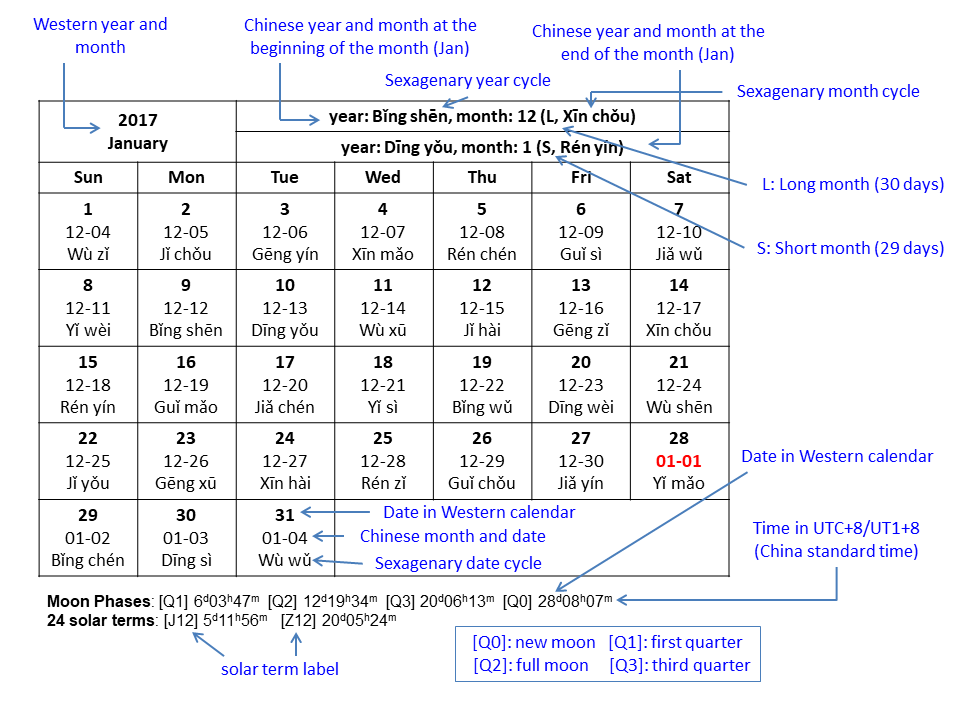Conversion between Western and Chinese Calendar (722 BCE — 2200 CE)
Enter a year between -721 and 2200:
(0 = 1 BCE, -1 = 2 BCE, -2 = 3 BCE and so on. BCE = before common era, CE = common era.)
Julian dates at noon:
Explanation
The information in the calendar table is explained in the diagram below. The example is taken from January, 2017.

The month and date in the Chinese calendar is denoted by MM-DD in the calendar table. For example, 12-29 means the 29th day in the 12th month of the Chinese calendar. A Chinese year usually has 12 months. Each month can have 30 days (long month) or 29 days (short month). To keep the calendar in sync with seasons, a leap (intercalary) month is added about every three years so that the year has 13 months. A leap month works in a similar way as a leap day in the Gregorian calendar, but an extra month is inserted in the year instead of an extra day. The leap month is indicated by the same number as the previous month, but a "leap" is added before the number. For example, there was a leap month after month 6 in the Chinese year in 2017. The month is denoted by "leap 6".
A Chinese year is labelled by its sexagenary year cycle. Sexagenary cycle is also used to label the month and date in the Chinese calendar. Sexagenary month cycles are rarely used and they are provided only after 105 BCE. A brief introduction to the sexagenary cycle is given on this page.
For simplicity, the symbols Q0, Q1, Q2 and Q3 are used to represent "new moon", "first quarter", "full moon" and "third quarter". At the bottom of each month, the Gregorian/Julian dates of the four moon phases and 24 solar terms occurring in the month are listed. The times are given in the China standard time (meridians of 120° East). A brief introduction to the 24 solar terms is given on this page.
Solar and lunar eclipses associated with the new moons and full moons are indicated with links to pages describing the eclipse circumstances. For more information about solar and lunar eclipses, visit my Eight Millennia of Eclipses website.
Calendrical solar terms are listed for years before 1734. They refer to the 24 solar terms calculated according to the calendar at that time. They were defined by píngqì (i.e. the mean motion of the Sun) before 1645 and dìngqì (i.e. the motion of the true Sun) in and after 1645. The 24 solar terms listed above these calendrical solar terms are based on the current definition (which is also based on dìngqì) and are calculated by a modern method. Times are given in the China standard time (meridians of 120° East). The difference between píngqì and dìngqì is explained on our solar term page. The dates of the calendrical solar terms after 1733 were mostly the same as the dates calculated using the modern method and therefore they are omitted, except when there were discrepancies.
Gregorian calendar is shown on Oct. 15, 1582 and afterwards. Julian calendar is shown before Oct. 15, 1582. Proleptic Julian calendar is shown before 8 CE (CE = common era).
Julian dates are the number of days and fractions counting from the time origin at noon on January 1, 4713 BCE (before common era). Hence Julian dates at noon are integers. A time zone is not specified here and it is assumed that the time origin (noon on January 1, 4713 BCE) and the time at noon on any day are both in the same time zone. Julian dates at noon will be shown at the bottom of each day if enabled. I also created the web-based Julian and sexagenary date calculator.
You can enter the year using the URL query string "?y=[year]". For example, to show the calendar for 1850, use the (relative) URL index.html?y=1850. This won't work if the y parameter in the query string is not a number or is outside the range [-721, 2200].
The Chinese calendar on this website are computed using the methods described here.